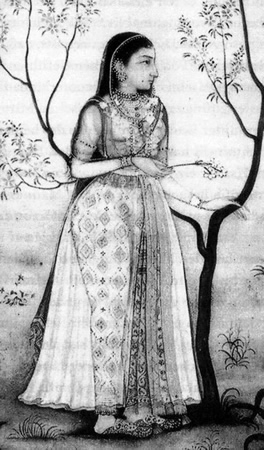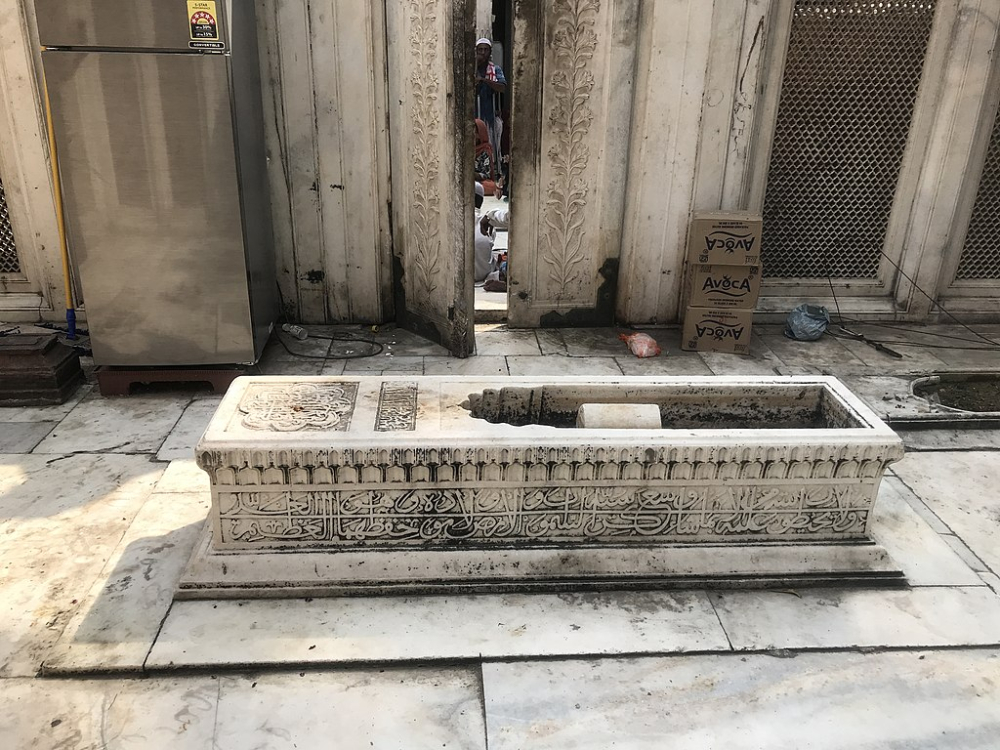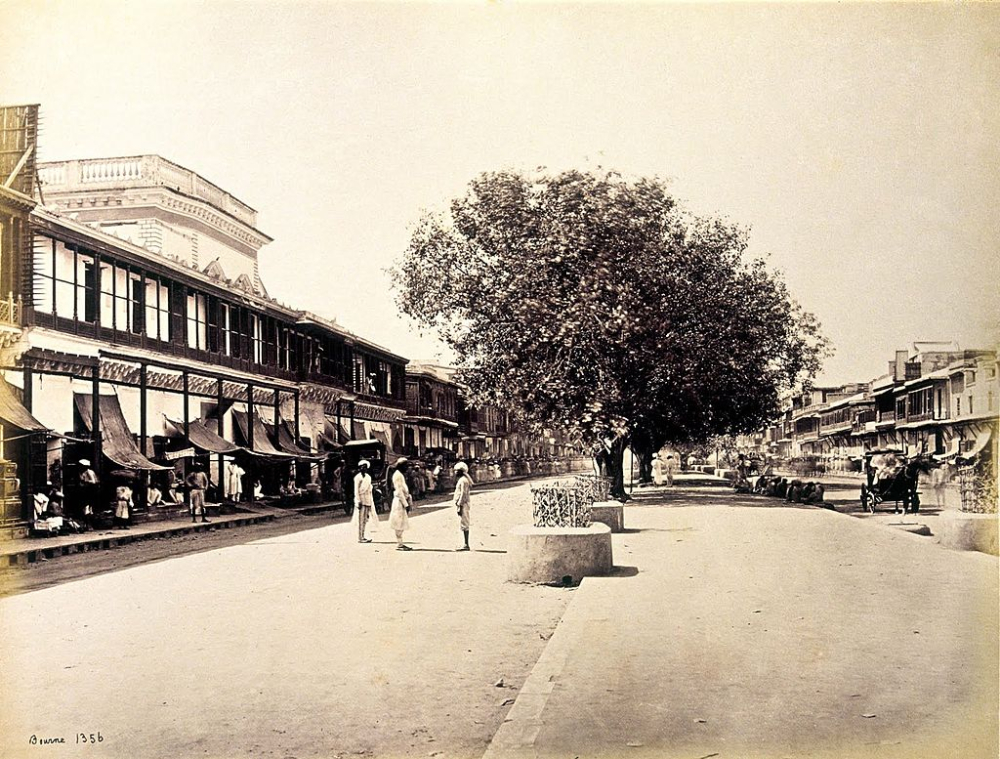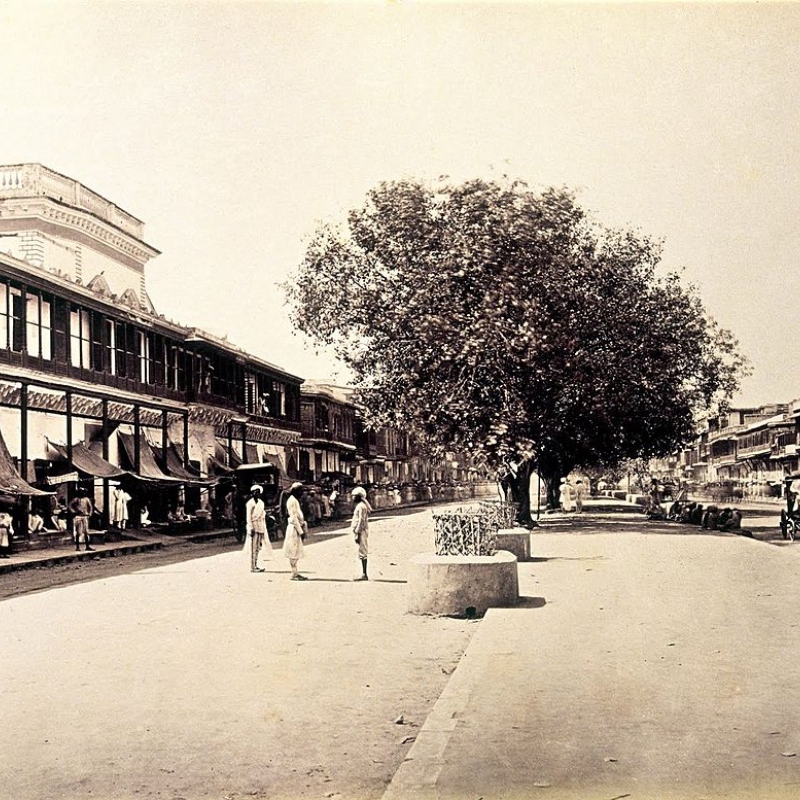Although Chandni Chowk is a clumsy, congested market with narrow alleys today, it was once the centre of trade in Shahjahanabad. Built in 1650 by Jahanara Begum, daughter of Mumtaz Mahal and Emperor Shah Jahan, this glorious bazaar has a distinct charm that remains unmatched. (Photo Courtesy: Samuel Bourne [Public Domain])
When talking about Mughal-era monuments, we often take the names of Shah Jahan, Akbar and Jahangir, who built forts, mosques and gardens across northern India and what is now Pakistan. However, a certain section of patrons remains uncredited—the women of the Mughal court. Their cultural contribution is most evident in Delhi. Much like Humayun’s first wife Bega Begum—who commissioned her husband’s stunning tomb—Zinat-ul Nissa, Fatehpuri Begum and Begum Samru are some of the other Mughal women who conceived of monuments such as the Fatehpuri Masjid, Zinat-ul Masjid and what is today known as Begum Samru’s haveli, respectively. Even Chandni Chowk, an area that continues to be regarded as the heart of Delhi, owes its existence to Shah Jahan and Mumtaz Mahal’s eldest daughter, Jahanara Begum.
Jahanara, the Patron
After the death of her mother in 1631,[i] Jahanara was made the Padsah Begum (First Lady), the most powerful woman in the city. Described as ‘discreet, generous, open-minded and charitable’ and ‘adored by all’[ii] by Venetian traveller Niccolo Manucci, the princess worked to strengthen Shahjahanabad’s influence by establishing trade relations with Dutch merchants. She bought ships docked at Surat and invested in numerous karkhaanas (factories). [iii] ‘Her wealth enabled her to patronise works of learning, particularly Sufi works, such as commentaries on Maulana Rumi’s Masnavi,’ wrote historian Swapna Liddle, author of Chandni Chowk: The Mughal City of Old Delhi.[iv] Among her many contributions to Delhi’s landscape, Jahanara commissioned caravanserais, a charbagh (a rectangular garden divided into quadrilaterals) called Begum ka Bagh and a canal in an area of Shahjahanabad, which would eventually become the famous Chandni Chowk.

After the death of her mother in 1631, Jahanara was made Padsah Begum (First Lady), the most powerful woman in the Delhi (Courtesy: Kellerassel [Public Domain])
The Moonlight Square
In Shahjahanabad: The Sovereign City in Mughal India 1639–1739, Stephen Blake recounts that Jahanara once said: ‘I will build a sarai, large and fine like no other in Hindustan. The wanderer who enters its courts will be restored in body and soul and my name will never be forgotten.’[v] The sarai (rest house) was a part of Chandni Chowk, where the Delhi Town Hall now stands.
Built in 1650, the bazaar, which initially had no formal name, was conceived by Jahanara. It stretched from Shahjahanabad’s Lahori Gate to the Fatehpuri Masjid (built by Shah Jahan’s wife Fatehpuri Begum in the same year). The 120-ft wide bazaar stretched for more than a kilometre and was a spectacle to behold.[vi] It had 1560 shops that traded in a variety of items ranging from kebabs, rubies and emeralds to flowers, glass huqqas and eyeglasses from China. The Urdu Bazaar housed soldiers, artisans, clerks and artists of the Mughal court, while the Ashrafi or Jauhari Bazaar was the financial hub. Amirs (senior officials) gathered for mushairas (a social gathering where poetry is read) and daily news reports in the market’s coffeehouses.[vii] Even though the bazaar was primarily a place of trade, Jahanara made sure it was aesthetically planned.
A charming canal flowed through the market, and trees flanked the road on either side, providing shade to passers-by. At the centre of the bazaar, the canal broadened to form an octagonal pool. To the north of this pool, Jahanara built a caravanserai (an inn for accommodation of caravans) and to the south a hammam (a communal bathhouse). On some nights, the moonlight reflected in the central pool, earning it the name ‘Chandni Chowk’ (Moonlight Square). The 18th-century writer Rai Chaturman Kayath, in his account Chahar Gulshan, wrote:
The canal brought greenness to Delhi. It ran in all of the city from lane to lane and the wells became full from it. Having flowed to the mansions of the princes and amirs it flowed into the city – to Chandni Chowk, to the chawk of Sa’adullah Khan, to Paharganj, to Ajmiri Gate, to the grazing places, to the other mahallahs (urban divisions in Islamic communities) and to all the lanes and bazaars of the city.[viii]

Chandni Chowk continued to function as a major thoroughfare in Shahjahanabad even after Jahanara’s death in 1681 (In pic: Jahanara's tomb, Courtesy: Indrajit Das [CC BY-SA 4.0]
The French traveller–physician François Bernier considered the caravanserai next to Bagh Sahibabad in Chandni Chowk to be ‘the most imposing structure in the city after the Jama Masjid’.[ix] Describing the imposing caravanserai, Blake wrote that it was an ‘outstanding example of its type’ and that ‘only the rickets and the most eminent of Persian and Uzbek merchants were allowed to put up there’.[x]
The Fall of a City
Chandni Chowk continued to function as a major thoroughfare in Shahjahanabad even after Jahanara’s death in 1681. It grew from a bazaar to a site with historical value. However, during the Mutiny of 1857, Chandni Chowk was heavily bombarded and many buildings were damaged. Once the British gained control of the walled city, they razed Shahjahanabad’s glorious architecture and erased the monumental memory of Mughal power to prevent future rebellions. Barracks replaced the buildings inside the walled city. The British not only covered the canal but also replaced the caravanserai with the Delhi Town Hall. While laying railway lines in Delhi in the 1860s, Bagh Sahibabad was demolished. Chandni Chowk was further ravaged during the three British Durbars or coronation ceremonies—held in 1877, 1903 and 1911—to construct new buildings.[xi]

Today, Chandni Chowk might not be as graceful as it was, but it is still an avenue where Delhi’s history can be witnessed at every turn (Courtesy: Samuel Bourne [Public Domain])
Today, Chandni Chowk no longer boasts the aesthetic beauty it once possessed. After the Mutiny of 1857, its elegant structures, along with Jahanara’s legacy, were also razed to the ground. Though only a few decrepit walls and jharokhas (ornate windows) from the Mughal era remain in the area today, the magic of the past era remains. It might not be as graceful as it was, but it is still an avenue where Delhi’s history can be witnessed at every turn.
This article was also published on Firstpost.
Notes
[i] Encyclopaedia Iranica, ‘Jahanara Begum’, n.d., accessed July 16, 2019, http://www.iranicaonline.org/articles/jahanara-begum.
[ii] Waldemar Hansen, The Peacock Throne: The Drama of Mogul India (New Delhi: Motilal Banarsidass Publications, 1986), 99.
[iii] Shadab Bano, ‘Jahan Ara’s Administration of her Jagirs,’ Proceedings of the Indian History Congress 66 (2005–06): 430–37.
[iv] Swapna Liddle, ‘Women Patrons and the Making of Shahjahanabad,’ Sahapedia, 2017, accessed July 16, 2019, https://www.sahapedia.org/women-patrons-and-the-making-of-shahjahanabad.
[v] Stephen P. Blake, Shahjahanabad: The Sovereign City in Mughal India, 1639–1739 (New Delhi: Cambridge University Press, 2002), 66.
[vi] Ibid., 55.
[vii] Swapna Liddle, ‘Women Patrons and the Making of Shahjahanabad,’ Sahapedia, 2017, accessed July 16, 2019, https://www.sahapedia.org/women-patrons-and-the-making-of-shahjahanabad.
[viii] Stephen P. Blake, Shahjahanabad: The Sovereign City in Mughal India, 1639–1739 (New Delhi: Cambridge University Press, 2002), 67.
[ix] Ibid., 66.
[x] Ibid.
[xi] Delhi Urban Art Commission, City Level Projects: Rejuvenation of Shahjahanabad (New Delhi: Delhi Urban Art Commission, 2017).












